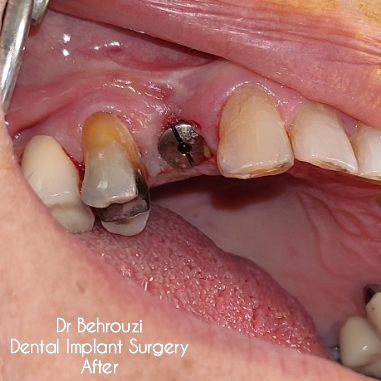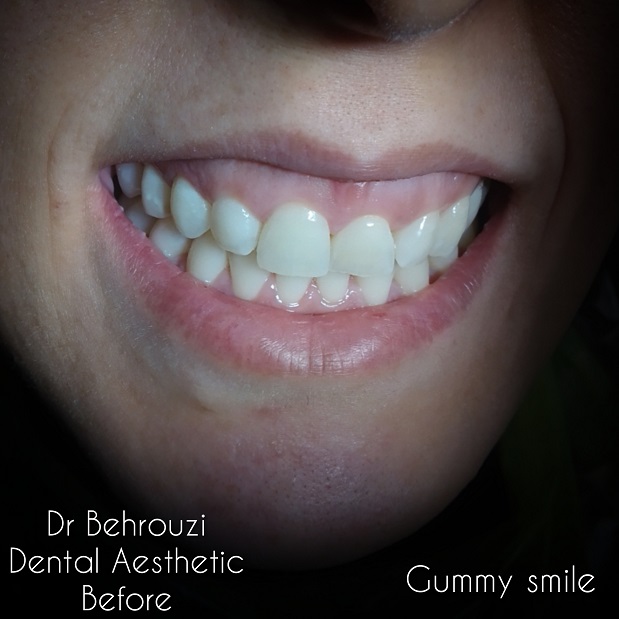Flapless implant surgery
Flapless implant surgery using a tissue punch technique can be successfully employed when replacing posterior teeth. Careful diagnosis and treatment planning are essential. The protocol for this procedure includes proper evaluation of bone type, height and width of the residual ridge, and amount of available keratinized tissue. The surgical technique should include use of a surgical stent, appropriate use of rotary punches and implant burs, and an osteotomy that promotes a stable implant.
A tissue punch is a simple and easy way to gain access to the underlying bone. It generally is chosen in our practice when there is : 1) excellent ridge width and there will be no bone needed i.e. mandibular posterior 2) excellent keratinized gingiva 3) good access to place the punch Advantages of the flapless implant surgery, include less traumatic surgery and decreased operative time, which result in accelerated postsurgical healing, fewer postoperative complications, and increased patient comfort and satisfaction. Another advantage of the flapless implant surgery is no bleeding,less pain and preservation of soft tissue profiles, including the gingival margins of the adjacent teeth and the interdental papillae.also accelerated osseointegration is occurred in this technique. Also, this method has more success in smokers.
Emaining buccal bone thickness after implant placement should be at least 2.0 mm to minimize postsurgical resorption. prerequisites for the flapless implant surgery include sufficient bone width and height, adequate keratinized soft tissue, and an absence of significant tissue undercuts. First, sufficient amounts of available bone and keratinized tissue are necessary because direct visualization of bone topography is limited and sacrifice of some keratinized tissue, although minimal, is inevitable in this particular technique.Although debatable, the presence of peri-implant keratinized tissue is regarded beneficial, especially for the longevity of rough surfaced implants. An adequate amount (i.e., more than 2 mm) of keratinized tissue must remain on the facial aspect of the implant site after tissue punch. If the soft tissue is insufficient or not expected to be esthetically pleasing after the flapless surgery, soft tissue grafting procedures or papilla regeneration techniques should be considered. In addition to the factors described previously for case selection, precautions should be taken during surgical and prosthodontic procedures. Because of the lack of visibility of hard tissue contours in the flap, it is extremely crucial during implant site preparation to place implant drills against surgical stents using the full length of the apicocoronal drill orientation. Incorrect angulation of implant drills can cause perforation of the cortical plates, usually on the buccal aspect, resulting in dehiscence or fenestration. Although not presented here, perforation of the buccal plate is generally detected by palpation or by observation of implant threads through the soft tissue. With regard to immediate loading, primary stability should be confirmed with hand-torquing of the provisional abutment. If any movement is noted during handtorquing, a delayed loading protocol should be consider
Treatment cost in this way compared to dental flap implant surgery is Less about 400-500$ (in 2015 in iran)
ایمپلنت (کاشت دندان) به روش پانچ(Punch flapless technique)
گذاشتن ایمپلنت دندانی با دو روش جراحی در دهان بیمار انجام پذیر است:
روش جراحی فلپ که در آن لثه بیمار با تیغ جراحی برش داده شده و پس از دریل کردن استخوان و جایگذاری ایمپلنت،ناحیه جراحی بخیه زده می شود که از پیامدهای این روش درد، خونریزی و تورم پس از جراحی می باشد.
روش جراحی بدون فلپ(Flapless) یا تکنیک پانچ که در آن لثه بیمار برش داده نمی شود بلکه با یک ابزار ویژه ، محل جراحی پانچ شده و پس از دریل استخوان و جایگذاری ایمپلنت،ناحیه پانچ شده با یک Cover screw یا درپوش ویژه پوشانده می شود.بنابراین بیمار هیچگونه خونریزی و تورم پس از جراحی نخواهد داشت.
مزایای روش جراحی پانج :
1-به دلیل آنکه در این روش، برش و بخیه نداریم بنابراین مدت زمان جراحی به یک سوم کاهش می یابد طوریکه می توان در مدت زمان 10 دقیقه ایمپلنت را گذاشت.
2-بیمار پس از جراحی هیچگونه خونریزی ندارد و بنابراین در بیمارانی که از داروهای ضد انعقادی استفاده می کنند ، این خود یک مزیت می باشد و جای هیچگونه نکرانی برای آنها وجود ندارد.
3-از آنجایی که در این روش از تیغ جراحی استفاده نمی گردد و بافت بیمار کمتر دستکاری می شود و میزان تروما و آسیب جراحی کاهش می یابد، بنابراین تورم و اکیموز پس از جراحی نداریم و درد پس از جراحی نیز بسیار ناچیز خواهد بود و به دنبال آن بیمار نیز نیاز به استراحت پس از درمان ندارد و می تواند بی درنگ به کارهای روزمره خود ادامه دهد.پس این یک نوع جراحی سرپایی است.
4-در این روش جراحی به دلیل آنکه بافت بیمار برش داده نمی شود بنابراین خونرسانی بافت بیمار کمتر دچار اختلال می شود و هر اندازه که خونرسانی بافت کمتر دچار اختلال شود،ترمیم و بازسازی بافت زودتر رخ می دهد و میزان عفونت کاهش می یابد.بنابراین مدت زمان جوش خوردن یا osseointegration کاهش می یابد و به دنبال آن مدت زمان انتظار بیمار برای روکش گذاری ایمپلنت نیز کاهش می یابد.
5-میزان موفقیت درمان در روش جراحی پانچ در افراد سیگاری به دلیل آسیب کمتربافت و اختلال کمتر در خونرسانی بافتی ، بیشتر می باشد.
روش پانچ در چه بیمارانی انجام پذیر است؟ در همه بیمارانی که شرایط استخوانی خوبی دارند و نیاز به پیوند یا پودر استخوان و یا شکل دهی استخوان ندارند،می توانند از این روش سود جویند.کسانی که دچار تحلیل شدید استخوان هستند و یا نیاز به جراحی سینوس لیفت (بالا بردن کف سینوس) دارند باید با روش جراحی فلپ ایمپلنت آنها را گذاشت.







